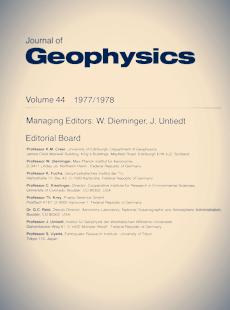Detection of meridional currents in the equatorial ionosphere
Article Sidebar

Vols. 1-18 (1924-1944), ISSN 0044-2801
Main Article Content
Abstract
Theoretical investigations predict meridional currents in the dynamo region of the ionosphere a few degrees north and south of the magnetic equator as a consequence of the equatorial electrojet. The magnetic fields of these currents are perpendicular to the permanent magnetic field of the Earth and cause a height variation of the magnetic declination. It was the aim of six rocket launches performed in 1970 near noon at Natal, Brazil, to detect these currents. To reach this objective, identical payloads each consisting of two flux-gate magnetometers, a solar aspect sensor, an experiment to measure the angle between the magnetic field and the direction to the Sun, and an impedance probe to determine the electron density were launched under different magnetic conditions. The predicted variation of the declination has been observed but with considerably higher amplitude than was expected. On the other hand, the measured height integrated current density in the west-east direction was smaller than deduced from ground based magnetic H-variations. These discrepancies can be explained by currents flowing at 5 degrees off the magnetic equator, on both sides, with intensities of about 0.3 of the electrojet intensity at the same height but in reversed direction. Such reversed currents have recently been observed from ground based magnetic observations by others and have also been interpreted theoretically by ionospheric wind effects.
 ARK: https://n2t.net/ark:/88439/y001006
ARK: https://n2t.net/ark:/88439/y001006
Permalink: https://geophysicsjournal.com/article/272
Article Details
References
Cain, J.C., Hendriks, W.E., Jensen, D.C. (1968) Computation of the main geomagnetic field from spherical harmonic expansions. Data Users Note NSSDC 68-11. National Space Science Data Center, Greenbelt
Davis, T.N., Burrows, K., Stolarik, J.D. (1967) A latitude survey of the equatorial electro jet with rocketborne magnetometers. J. Geophys. Res. 72:1845-1861
Fambitakoye, O., Mayaud, P.N. (1976) Equatorial electrojet and regular daily variation SR. I. A determination of the equatorial electrojet parameters. J. Atmos. Terr. Phys. 38:1-17
Fambitakoye, O., Mayaud, P.N. (1976) Equatorial electrojet and regular daily variation SR. II. The center of the equatorial electrojet. J. Atmos. Terr. Phys. 38:19-26
Fambitakoye, O., Mayaud, P.N., Richmond, A.O. (1976) Equatorial electrojet and regular daily variation SR. III. Comparison of observations with a physical model. J. Atmos. Terr. Phys. 38:113-121
Jacobs, K.G., Rawer, K. (1965) Electron density measurements in the ionosphere over the sahara with a variable frequency impedance probe, Space Res. 5:706-718
Jacobs, K.G., Rawer, K. (1966) Raketenmessungen mit einer Hochfrequenz-Impedanzsonde, Jahrbuch 1966 der WGLR, 378-384
Maynard, N.C. (1967) Measurements of ionospheric currents off the coast of Peru, J. Geophys. Res. 72:1863-1875
Melzner, F., Rabben, H.H. (1970) Elektronendichte-Messungen in der Ionosphare mit einer neuartigen HF-Impedanzsonde. J. Geophys. 36:135-150
Muhlhausen, K.H. (1974) Elektronendichtemessungen in der Ionosphare, Auswertung des Impedanzsondenexperiments der EEJ-Raketen. Diplom-Arbeit, Institut fuir Geophysik und Meterologie der Technischen Universitat Braunschweig, Braunschweig
Musmann, G. (1971) Verfahren zur Lagemessung von Raketen. GAMMA 15, Institut fur Geophysik und Meteorologie der Technischen Universitat Braunschweig, Braunschweig
Musmann, G., Seiler, E., Hansel, J. (1971) Bodenmessungen wahrend der EEJ-Raketenkampagne in Brasilien, Oktober 1970. GAMMA 19, Institut fur Geophysik und Meteorologie der Technischen Universitat Braunschweig, Braunschweig
Richmond, A.O. (1973) Equatorial electrojet. I. Development of a model including winds and instabilities. J. Atmos. Terr. Phys. 35:1083-1103
Rippen, H. (1975) Anwendung eines meridionale Strome berucksichtigenden Modells auf den aquatorialen Elektrojet in Brasilien. Diplom-Arbeit, Institut fur Geophysik und Meteorologie der Technischen
Universitat Braunschweig, Braunschweig
Sastry, T.S.G. (1973) Daily Variation of Geomagnetic Field at the Indian Stations under the Electrojet during Period of the July 1966 Proton Flare. J. Geophys. Res. 78:1692-1698
Sugiura, M., Poros, D.J. (1969) An improved model equatorial electrojet with a meridional current system. J. Geophys. Res. 74:4025-4034
Untiedt, J. (1967) A model of the equatorial electrojet involving meridional currents. J. Geophys. Res. 72:5799-5810











